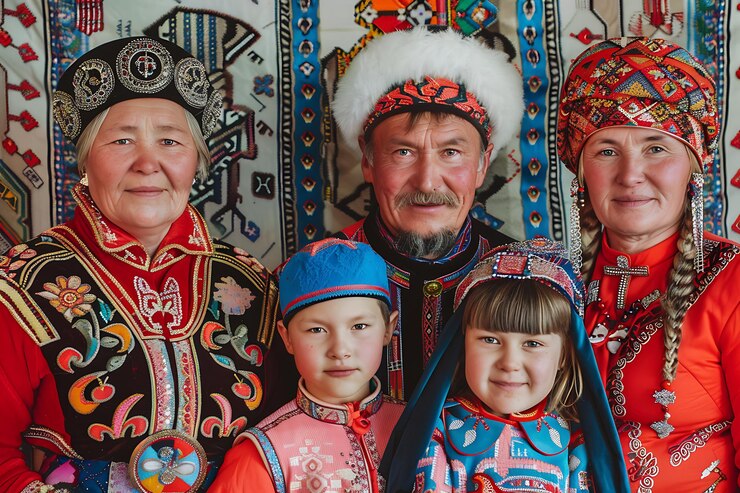The Kazak people, also known as Kazaks or Kazakhs, have a rich and diverse history that spans centuries. As the largest ethnic group in Kazakhstan, the Kazak have developed a unique culture shaped by their nomadic roots, traditions, and influences from neighboring regions. In this article, we will delve into the fascinating world of the Kazakhs, exploring their history, traditions, language, and the modern-day legacy of this proud people.
Who Are the Kazak?
The Kazak are a Turkic-speaking ethnic group primarily found in Kazakhstan, the largest landlocked country in Central Asia. While most Kazakhs live in Kazakhstan, there are also significant Kazakh communities in neighboring countries such as Russia, China, Uzbekistan, and Mongolia. Kazakhs are known for their nomadic traditions, which have been a key aspect of their culture for centuries.
Kazakhs speak the Kazakh language, which belongs to the Turkic language family. Although Kazakh is the official language of Kazakhstan, many Kazakhs are also fluent in Russian due to the country’s historical ties to the Soviet Union.
The History of the Kazak People
The Early Origins
The history of the Kazakh people can be traced back to the early Turkic tribes that inhabited the steppes of Central Asia. These nomadic groups roamed vast territories, relying on horseback riding and animal herding as their primary means of sustenance. The ancestors of the Kazakhs were part of these nomadic confederations, which played a significant role in shaping the culture and way of life of the Kazakh people.
The formation of the Kazakh identity began in the 15th century with the establishment of the Kazakh Khanate. This political entity emerged as a result of a split from the Uzbek Khanate, marking the beginning of a distinct Kazakh identity. Under the leadership of the Kazakh Khans, the Kazakh Khanate expanded its territory and consolidated its power over the vast Central Asian steppes.
The Golden Age of the Kazak Khanate
The 16th and 17th centuries are considered the golden age of the Kazakh Khanate. During this period, the Kazakh people experienced a period of relative stability and prosperity. The khans, or rulers, of the Kazakh Khanate maintained control over their territories and engaged in diplomatic relations with neighboring states, including the Russian Empire, China, and the Ottoman Empire.
One of the most famous Kazakh rulers of this era was Ablai Khan, who reigned in the 18th century. Ablai Khan is remembered for his efforts to unite the Kazakh tribes and protect the independence of the Kazakh people against external threats, particularly from the Russian Empire and the expanding Qing Dynasty of China.
The Decline of the Kazakh Khanate and Russian Colonization
In the late 18th and early 19th centuries, the Kazakh Khanate began to decline due to internal divisions and external pressures. The Russian Empire, seeking to expand its influence in Central Asia, gradually encroached upon Kazakh territory. By the mid-19th century, the Kazakh Khanate had effectively ceased to exist, and Kazakhstan became part of the Russian Empire.
Russian colonization had a profound impact on the Kazakh people. The nomadic way of life, which had been central to Kazakh culture for centuries, was disrupted as the Russian authorities encouraged the settlement of Russian and Ukrainian peasants on Kazak lands. This led to conflicts over land and resources, as well as the erosion of traditional Kazakh social structures.
The Soviet Era and the Kazak SSR
In 1917, the Russian Revolution led to the establishment of the Soviet Union, and Kazakhstan became part of the newly formed Soviet state. Under Soviet rule, Kazakhstan underwent significant changes. The Kazakh Autonomous Socialist Soviet Republic (Kazakh ASSR) was established in 1920, and in 1936, it was elevated to the status of the Kazakh Soviet Socialist Republic (Kazak SSR).
The Soviet government implemented policies aimed at modernizing Kazakhstan and integrating it into the broader Soviet system. These policies included forced collectivization, which had devastating effects on the Kazakh population. The forced collectivization of agriculture led to widespread famine in the early 1930s, resulting in the deaths of an estimated 1.5 million Kazakhs.
Despite these hardships, the Soviet period also brought some benefits to Kazakhstan. The establishment of infrastructure, education systems, and industrialization helped modernize the country. Additionally, Kazakhstan played a crucial role in the Soviet space program, with the Baikonur Cosmodrome serving as the launch site for the first human spaceflight in 1961.
Kazakhstan’s Independence
The dissolution of the Soviet Union in 1991 marked a new chapter in Kazakh history. Kazakhstan declared its independence on December 16, 1991, and Nursultan Nazarbayev became the country’s first president. Since gaining independence, Kazakhstan has emerged as a key player in Central Asia. With a growing economy and increasing international influence.
The transition to independence also allowed for a resurgence of Kazakh cultural identity. The government of Kazakhstan has worked to promote the Kazakh language and preserve traditional customs while also embracing modernization and globalization.
Kazak Culture and Traditions
Nomadic Heritage
At the heart of Kazakh culture is its nomadic heritage. For centuries, the Kazakh people lived as nomads, moving across the vast steppes of Central Asia in search of grazing land for their livestock. This nomadic way of life shaped many aspects of Kazakh culture, from clothing and cuisine to social structures and values.
One of the most iconic symbols of Kazakh nomadic culture is the yurt, a portable, round tent made of felt and wood. The yurt was the traditional dwelling of the Kazakh people, providing shelter and comfort in the harsh climates of the steppe. Even today, yurts are used in Kazakhstan for special occasions and cultural festivals.
Music and Dance
Kazakh music and dance play a central role in the country’s cultural heritage. Traditional Kazakh music is characterized by the use of the dombra, a two-stringed instrument that produces a distinctive sound. The dombra is often used to accompany traditional Kazakh songs, known as kuis, which tell stories of love, heroism, and the natural world.
In addition to music, dance is an important aspect of Kazakh culture. Kazakh folk dances often reflect the movements of animals, such as horses or eagles. And are performed during celebrations and festivals. These dances are a way for the Kazakh people to express their connection to nature and their nomadic roots.
Kazak Cuisine
Kazakh cuisine is a reflection of the country’s nomadic heritage and its reliance on livestock herding. Meat is a staple of the Kazakh diet, with popular dishes including beshbarmak (boiled meat served with noodles), kazy (horsemeat sausage), and kuyrdak (a dish made from liver, lungs, and heart). Dairy products, such as kymyz (fermented mare’s milk) and ayran (yogurt), are also important components of Kazakh cuisine.
Hospitality is a key value in Kazakh culture, and guests are often treated to elaborate meals as a sign of respect and friendship. Sharing food and drink is a way for Kazakhs to strengthen social bonds and demonstrate their generosity.
Festivals and Celebrations
Kazakhs celebrate a variety of festivals and holidays throughout the year, many of which are rooted in their nomadic traditions. One of the most important festivals is Nauryz, the Kazakh New Year, which is celebrated on March 21. Nauryz marks the beginning of spring and is a time for renewal, feasting, and community gatherings. During Nauryz, Kazakhs participate in traditional games, music, and dance, and share festive foods such as Nauryz kozhe, a special soup made from seven ingredients.
Other important celebrations include Kurban Ait (Eid al-Adha), which is observed by the Muslim Kazakh population, and Independence Day, which commemorates Kazakhstan’s declaration of independence from the Soviet Union in 1991.
The Modern-Day Legacy of the Kazakhs
Language and Identity
Since gaining independence in 1991, Kazakhstan has made significant efforts to promote the Kazakh language and culture. Kazak is the official language of the country, and there has been a renewed focus on ensuring that younger generations are fluent in the language. While Russian remains widely spoken, especially in urban areas, the promotion of Kazakh has become a key aspect of Kazakhstan’s national identity.
In recent years, Kazakhstan has also worked to preserve and promote its nomadic heritage. Cultural festivals, museums, and educational programs highlight the traditions and customs of the Kazakh people, ensuring that their unique cultural identity continues to thrive in the modern world.
Kazakh Contributions to Global Culture
Kazakhs have made significant contributions to global culture in various fields, including sports, art, and science. One of the most famous Kazakhs is Gennady Golovkin, a world-renowned professional boxer who has held multiple world championship titles. Golovkin’s success has brought international attention to Kazakhstan’s sports talent.
In the world of literature and art, Kazakh writers and artists are gaining recognition for their works that reflect the history and culture of their people. Additionally, Kazakhstan’s role in space exploration continues to be of global importance. With the Baikonur Cosmodrome remaining a key site for international space missions.
Kazakhstan’s Role in Central Asia
As the largest country in Central Asia, Kazakhstan plays a significant role in the region’s economic and political landscape. The country is rich in natural resources, particularly oil and gas. And has leveraged these resources to build a strong economy. Kazakhstan is also a member of various international organizations, including the United Nations. The Shanghai Cooperation Organization, and the Eurasian Economic Union.
Kazakhstan’s strategic location between Europe and Asia has made it an important hub for trade and diplomacy. The country’s leadership has worked to maintain stable relations with its neighbors. Including Russia, China, and Uzbekistan, while also seeking to strengthen ties with Western nations.
Conclusion
The Kazakh people have a long and storied history that has shaped their unique culture and traditions. From their nomadic roots on the Central Asian steppes to their modern-day contributions to global culture and politics. The Kazakhs have left an indelible mark on the world. Today, Kazakhstan is a thriving nation that continues to embrace its rich cultural heritage. While looking towards a bright and prosperous future.
FAQs
What is the origin of the Kazakh people?
The Kazakhs are descended from early Turkic-speaking nomadic tribes that roamed the steppes of Central Asia. The formation of the Kazakh identity began with the establishment of the Kazakh Khanate in the 15th century.
What are the main traditions of the Kazakh people?
Kazakhs have a rich nomadic heritage, and many of their traditions are rooted in this way of life. Important traditions include hospitality, music and dance, and the celebration of festivals such as Nauryz.
What is the Kazakh language?
Kazakh is a Turkic language and the official language of Kazakhstan. It is written using the Cyrillic alphabet, though there are plans to transition to the Latin alphabet in the coming years.
What are some traditional Kazakh dishes?
Traditional Kazakh dishes include beshbarmak (boiled meat with noodles), kazy (horsemeat sausage), and kymyz (fermented mare’s milk).
What is Kazakhstan’s role in the modern world?
Kazakhstan is a major player in Central Asia, with a strong economy based on its natural resources. The country plays an important role in regional politics and diplomacy. And is known for its contributions to global culture and space exploration.







